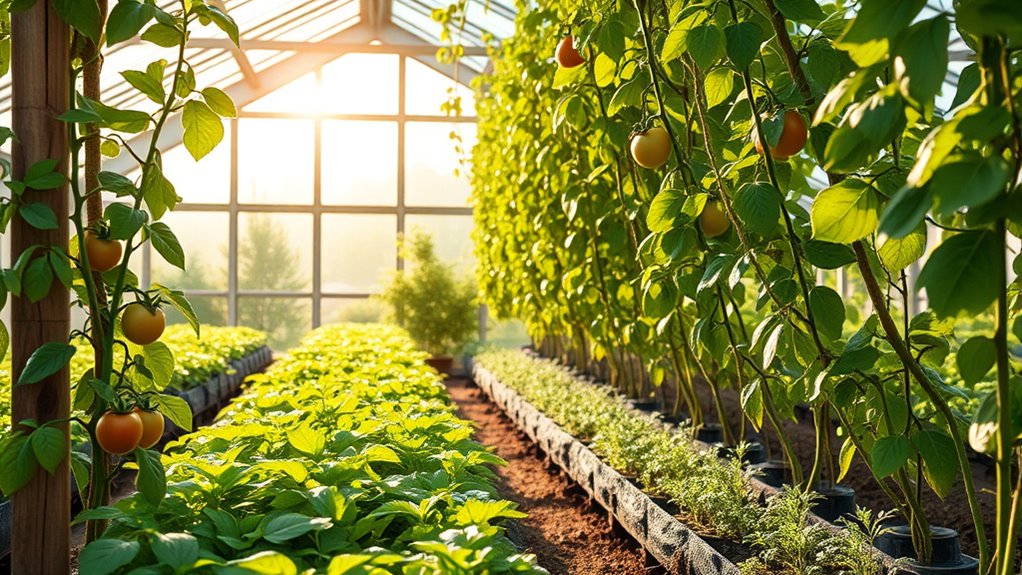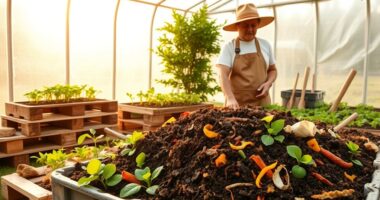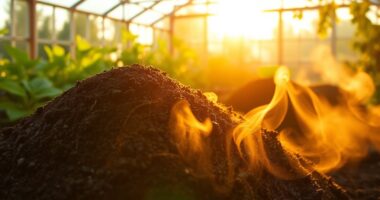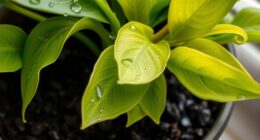To grow in a greenhouse without chemicals, focus on healthy soil by using organic amendments like compost and organic fertilizers. Introduce beneficial insects such as ladybugs to naturally control pests, and use natural repellents like neem oil or garlic spray. Practice crop rotation, companion planting, and guarantee good airflow to prevent diseases. Maintaining ideal environmental conditions naturally will support vibrant, resilient plants. Keep exploring for more tips to create a sustainable, eco-friendly greenhouse.
Key Takeaways
- Use high-quality organic soil enriched with compost and natural fertilizers like seaweed extract and fish emulsion.
- Incorporate beneficial insects, such as ladybugs and parasitic wasps, for natural pest control.
- Employ natural repellents like neem oil, garlic spray, and companion planting to deter pests without chemicals.
- Maintain optimal environment conditions with natural ventilation, shading, and humidity control to prevent pests and diseases.
- Implement crop rotation, plant diversity, and eco-friendly practices to promote a healthy, chemical-free greenhouse ecosystem.
Choosing Organic Soil and Amendments

Have you ever wondered how to create a healthy, chemical-free greenhouse environment? The first step is choosing organic soil and amendments. Start by selecting high-quality, organic soil free from synthetic chemicals.
Create a healthy greenhouse with organic soil and chemical-free amendments for vibrant, sustainable growth.
To guarantee your soil is free of pests and diseases, consider soil sterilization methods like solarization or heat treatment. Incorporating composting techniques to enrich your soil naturally; compost made from kitchen scraps, yard waste, and other organic materials boosts soil fertility and structure. Using compost as an amendment helps introduce beneficial microbes that support healthy plant growth. Additionally, understanding sound vibrations and their influence on cellular regeneration can inspire complementary practices that promote plant vitality and soil health. Recognizing the importance of local resources can further enhance your gardening success by providing access to quality organic materials. Engaging with educational programs about sustainable gardening methods can also improve your knowledge and practices. Focusing on soil health management techniques ensures long-term fertility and resilience of your greenhouse ecosystem. Incorporating soil sterilization methods can help prevent the buildup of pests and diseases over time. Avoid chemical fertilizers and synthetic amendments, focusing instead on organic options. This approach creates a balanced, vibrant environment for your plants, minimizes chemical runoff, and promotes sustainable gardening practices from the ground up.
Incorporating Beneficial Insects to Manage Pests
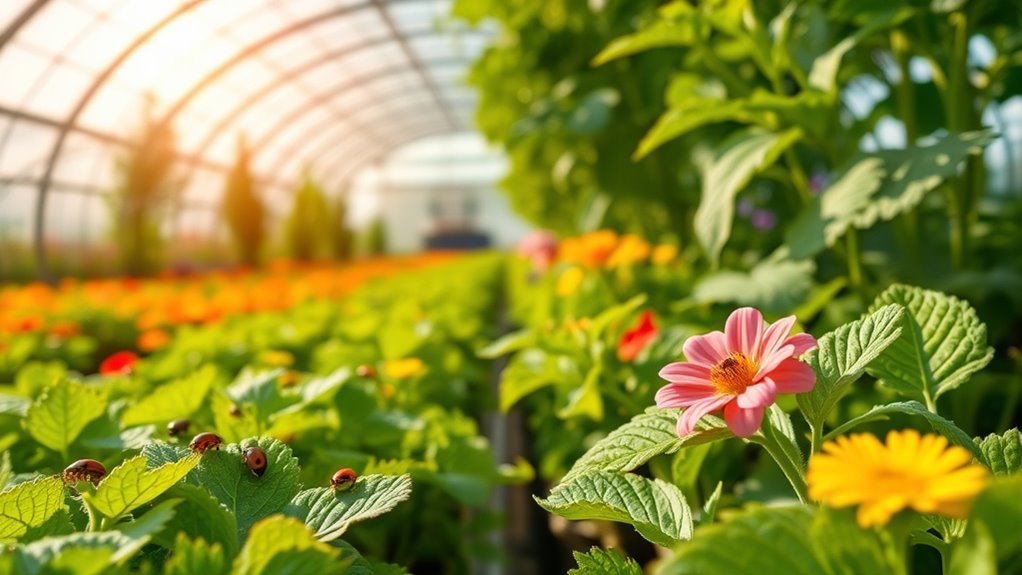
Did you know that releasing beneficial insects can be one of the most effective ways to control pests in your greenhouse? By introducing natural predators like ladybugs or parasitic wasps, you reduce reliance on chemicals. Using vetting processes to select high-quality beneficial insects ensures their effectiveness and safety for your plants. To succeed, create beneficial insect habitats—plant flowering plants or add shelter to encourage their presence. Regular insect population monitoring helps you track their numbers and effectiveness. Maintaining emotional alignment with your gardening goals can improve your success rate and create a more harmonious ecosystem. Proper beneficial insect selection is essential for ensuring the pests are kept in check without disrupting your plants’ health. The selection of high-quality beneficial insects through proper vetting is crucial for optimal pest control and plant health. Here are some tips to get started:
- Select the right beneficial insects for your pests
- Establish habitats with native plants or shelter
- Release insects early in the pest lifecycle
- Avoid broad-spectrum pesticides that harm beneficials
- Keep an eye on insect populations regularly
Using Natural Pest Repellents and Deterrents
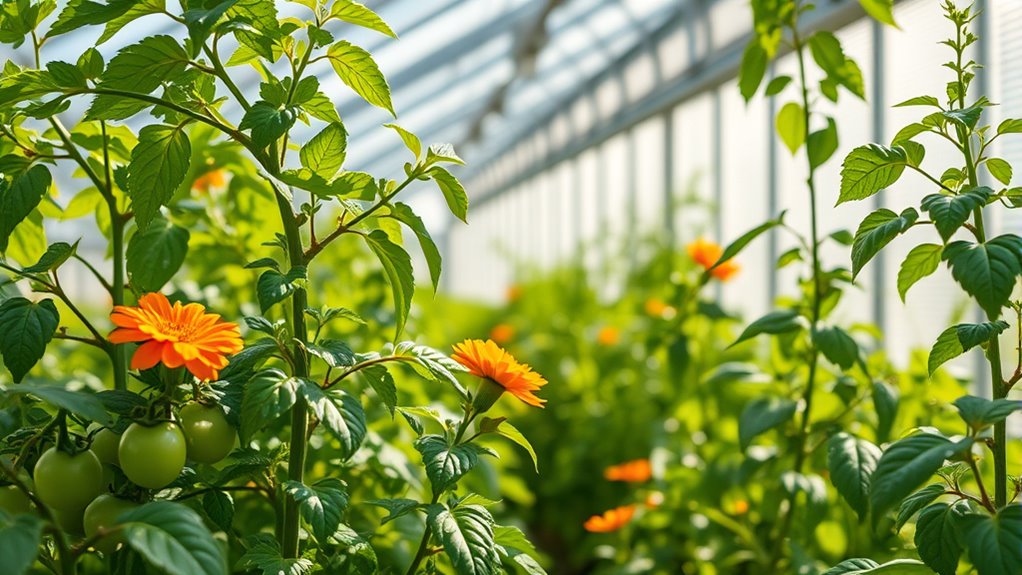
You can protect your plants by using natural pest repellents like neem oil or garlic spray, which deter unwanted insects without chemicals. Companion planting also works well; planting herbs like basil or marigolds nearby can naturally repel pests. Incorporating these strategies helps keep your greenhouse healthy and chemical-free. Additionally, using natural pest control methods such as introducing beneficial insects or using organic deterrents can further enhance your pest management approach. Incorporating environmentally friendly practices aligned with sustainable gardening principles can also promote a healthier greenhouse ecosystem. Understanding the importance of pest management in maintaining plant health is essential for long-term success.
Natural Pest Repellents
Are chemical pesticides really the only way to keep pests at bay? Not at all. Natural pest repellents are a safe, eco-friendly alternative that can effectively deter pests without harming your plants or the environment.
You can use simple ingredients like garlic, neem oil, or chili sprays as natural pest repellents, which act as effective pest deterrents. These methods are easy to prepare and apply, reducing reliance on chemicals. Incorporating integrative approaches into your gardening routine can also be a fun analogy, showing how effective and valuable natural methods can be. Additionally, understanding how Glycolic Acid benefits improve skin health highlights the importance of natural solutions over harsher chemicals in various contexts.
Incorporate these into your gardening routine to keep pests away naturally and protect your greenhouse ecosystem.
- Repurpose garlic and chili sprays for pest control
- Use neem oil as a natural insecticide
- Introduce beneficial insects like ladybugs
- Apply diatomaceous earth around plants
- Use essential oils like peppermint or eucalyptus
- Be aware of potential allergy risks associated with certain natural repellents.
Companion Planting Strategies
Companion planting offers a natural way to enhance pest control by strategically pairing plants that repel or deter unwanted insects. By creating plant alliances, you can reduce the need for chemicals while supporting healthy growth. Incorporating plant pairing strategies into your gardening routine might seem unusual, but sharing poetic sentiments can foster a positive and caring environment for your plants. Selecting pollination partners is essential, as certain plants attract beneficial insects that naturally protect your crops. For example, marigolds planted alongside tomatoes deter nematodes and attract pollinators, boosting fruit set. Herbs like basil and dill can repel pests while attracting pollinators, strengthening your plant alliances. Combining plants with complementary traits not only improves pest resistance but also enhances pollination, leading to better yields. Use this strategy to naturally balance your greenhouse ecosystem, creating a resilient environment that minimizes pests and maximizes productivity without chemicals.
Implementing Crop Rotation and Companion Planting

By rotating crops and pairing plants strategically, you can improve soil health and reduce pest issues naturally. This diversity keeps pests and diseases at bay while boosting your garden’s productivity.
Exploring which plants work best together can make your greenhouse more resilient and sustainable.
Crop Diversity Benefits
Implementing crop rotation and companion planting enhances greenhouse gardening by increasing crop diversity, which naturally suppresses pests and reduces disease spread. When you vary crops, you break pest cycles and prevent soil depletion.
Using pest resistant varieties alongside crop rotation keeps harmful insects at bay without chemicals. Diverse planting also attracts beneficial insects that control pests naturally.
You’ll notice healthier plants, fewer outbreaks, and better yields overall.
- Reduce reliance on chemical pesticides
- Break pest and disease cycles
- Improve soil health naturally
- Attract helpful insects
- Maximize space efficiency
Strategic Plant Pairing
Strategic plant pairing involves carefully selecting and arranging crops to optimize their growth and pest resistance. By combining compatible plants, you can enhance natural pollination techniques, encouraging better fruit and seed production without chemicals.
For example, planting flowers like marigolds alongside vegetables attracts pollinators and repels pests. Additionally, understanding plant growth regulators helps you manage plant development naturally. Certain companion plants release substances that influence growth rates or flowering times, improving overall health.
Crop rotation also plays an essential role, preventing soil depletion and reducing disease build-up. When planning your greenhouse, consider plant pairings that support each other’s growth cycles and attract beneficial insects, creating a balanced ecosystem.
This strategy reduces reliance on chemical interventions, promoting a healthier, more sustainable environment.
Maintaining Optimal Environmental Conditions Naturally
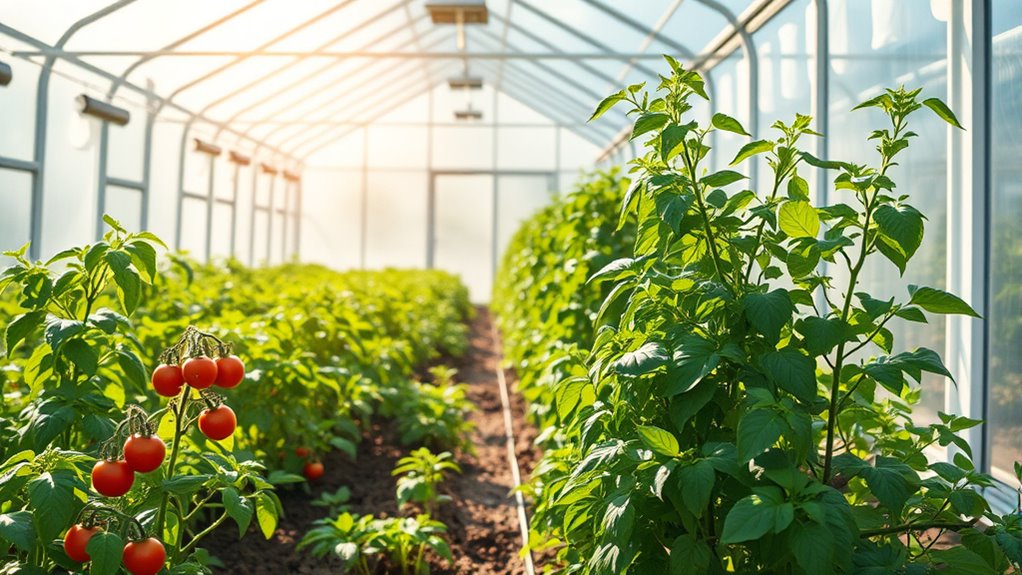
Maintaining ideal environmental conditions naturally is essential for healthy greenhouse gardening without chemicals. You need to focus on humidity control and airflow enhancement to create a thriving environment. Proper humidity levels prevent diseases and plant stress, while good airflow ensures fresh air circulation and temperature regulation.
Creating a healthy greenhouse environment relies on natural humidity control and airflow for disease prevention and plant vitality.
To achieve this, consider natural methods like venting, shading, and using fans powered by solar energy. Monitoring tools help you keep track of humidity and temperature, allowing quick adjustments.
Remember, a balanced environment reduces the need for chemical interventions and promotes strong, healthy plants.
- Use shade cloths to prevent overheating
- Install solar-powered vents for natural airflow
- Keep humidity levels consistent with natural moisture sources
- Regularly prune for airflow improvement
- Position fans strategically for optimal circulation
Utilizing Homemade Organic Fertilizers and Boosters
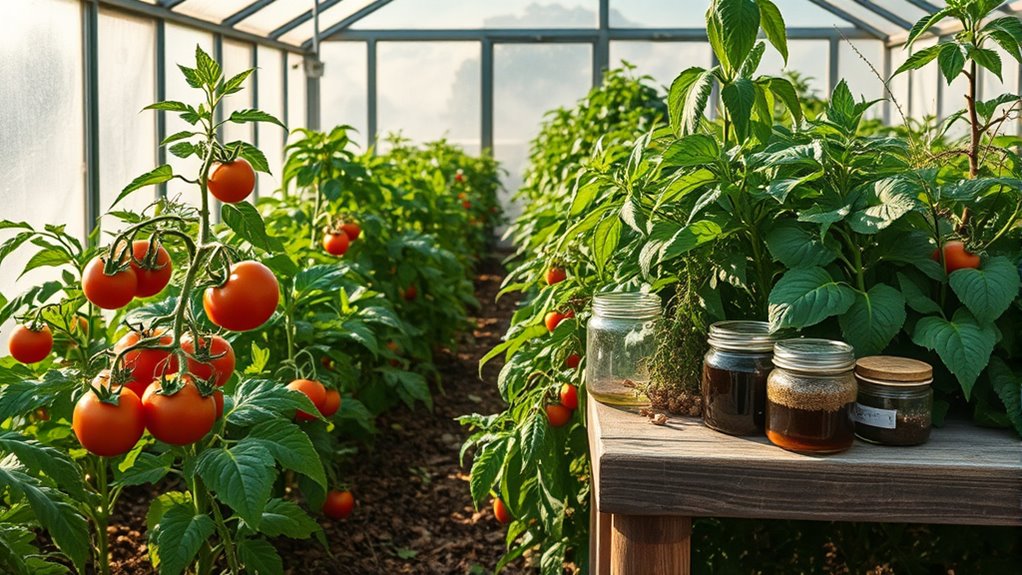
Using homemade organic fertilizers and boosters is an effective way to nourish your greenhouse plants naturally and sustainably. You can start with homemade composting, which transforms kitchen scraps and yard waste into nutrient-rich soil. This compost provides essential minerals and improves soil structure, promoting healthy root development.
To boost plant growth further, consider natural growth boosters like seaweed extract, fish emulsion, or compost tea. These organic solutions stimulate plant vitality without chemicals, ensuring a clean environment for your greenhouse.
Applying these homemade fertilizers regularly helps maintain balanced nutrition and supports robust plant health. By relying on homemade composting and natural growth boosters, you create a self-sustaining system that enhances productivity while keeping your gardening practices eco-friendly.
Practicing Integrated Pest Management Strategies
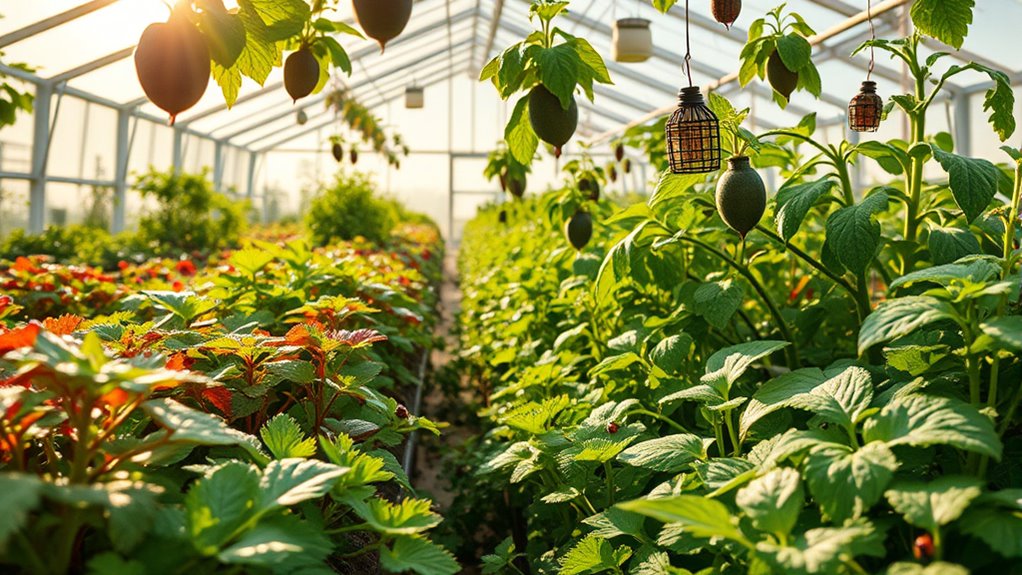
Practicing integrated pest management (IPM) is essential for keeping pests under control while minimizing chemical use in your greenhouse. Start by regularly conducting pest monitoring to identify issues early.
Use biological control agents, like beneficial insects, to naturally suppress pest populations. Combine cultural practices, such as proper spacing and sanitation, to reduce pest habitats.
Trap pests with sticky pads or pheromone traps to track activity levels. Always evaluate pest levels before deciding on intervention, avoiding unnecessary treatments.
Incorporate natural predators and ensure plant health to make pests less likely to attack. By integrating pest monitoring and biological control, you create a balanced environment that reduces reliance on chemicals and promotes healthy plant growth.
This approach keeps your greenhouse eco-friendly and productive.
Designing a Sustainable and Eco-Friendly Greenhouse Layout

Designing a sustainable and eco-friendly greenhouse layout begins with thoughtful site selection and efficient space planning. Choose a location with good airflow, natural sunlight, and access to water, reducing the need for artificial climate control.
Incorporate hydroponic systems to grow plants without soil, minimizing water waste and chemical use. Position these systems where they maximize space and ease of maintenance.
Optimize indoor lighting by installing energy-efficient LEDs that provide the right spectrum for plant growth while conserving power. Use reflective surfaces to improve light distribution and reduce energy needs.
Consider natural ventilation and shading to regulate temperature naturally. A well-designed layout balances plant needs with energy efficiency, making your greenhouse both sustainable and eco-friendly.
Frequently Asked Questions
How Can I Prevent Diseases Naturally in Greenhouse Plants?
To prevent diseases naturally, you should focus on good practices like crop rotation and using compost teas. Rotate your plants regularly to reduce soil-borne pathogens, and apply compost teas to boost beneficial microbes that fight off diseases.
Keep your greenhouse clean, guarantee proper air circulation, and avoid overwatering. These strategies help maintain healthy plants and minimize the need for chemicals, creating a thriving, disease-resistant environment.
What Are the Best DIY Methods for Pest Control?
Think of pest control like a well-orchestrated dance. You can DIY by planting companion plants that repel pests and attract beneficial insects that naturally keep pests in check.
Introduce ladybugs or predatory mites to your greenhouse, and use homemade sprays like neem oil or garlic solution. These methods work in harmony, creating a balanced ecosystem that minimizes pests without chemicals, letting your plants thrive naturally.
How Do I Select Eco-Friendly Greenhouse Materials?
When selecting eco-friendly greenhouse materials, you should focus on sustainability and safety. Look for recycled or biodegradable options, like natural mulching to enrich your soil.
Consider using materials that allow for compost tea to boost plant health naturally. Choose glass or recycled plastics for glazing, and opt for non-toxic, environmentally friendly framing.
These choices help maintain a chemical-free environment while supporting healthy plant growth.
Can I Grow Organic Vegetables Year-Round Indoors?
Think of your indoor garden as a year-round oasis. Yes, you can grow organic vegetables indoors throughout the year.
You’ll need to master composting techniques to enrich your soil naturally and choose the right seed selection for your climate.
Consistent light, proper watering, and maintaining a healthy environment are key.
With dedication, your indoor space becomes a lush, thriving vegetable garden, no matter the season outside.
What Are Sustainable Watering Practices Without Chemicals?
You can adopt sustainable watering practices by focusing on natural water conservation methods. Use rainwater harvesting to collect and store rainwater, reducing reliance on tap water.
Water your plants early in the morning or late in the evening to minimize evaporation.
Mulching around plants helps retain moisture, decreasing watering frequency.
These eco-friendly approaches guarantee your garden stays healthy while conserving water naturally, supporting a chemical-free, sustainable gardening routine.
Conclusion
By embracing chemical-free practices, you create a lush, vibrant haven where plants thrive in harmony. Picture your greenhouse alive with buzzing beneficial insects, fragrant herbs, and healthy roots reaching deep into rich, organic soil. As you nurture each plant with natural fertilizers and thoughtful design, you craft a sustainable oasis that blooms with energy. With patience and care, your chemical-free greenhouse becomes a sanctuary of growth, beauty, and endless possibility.
